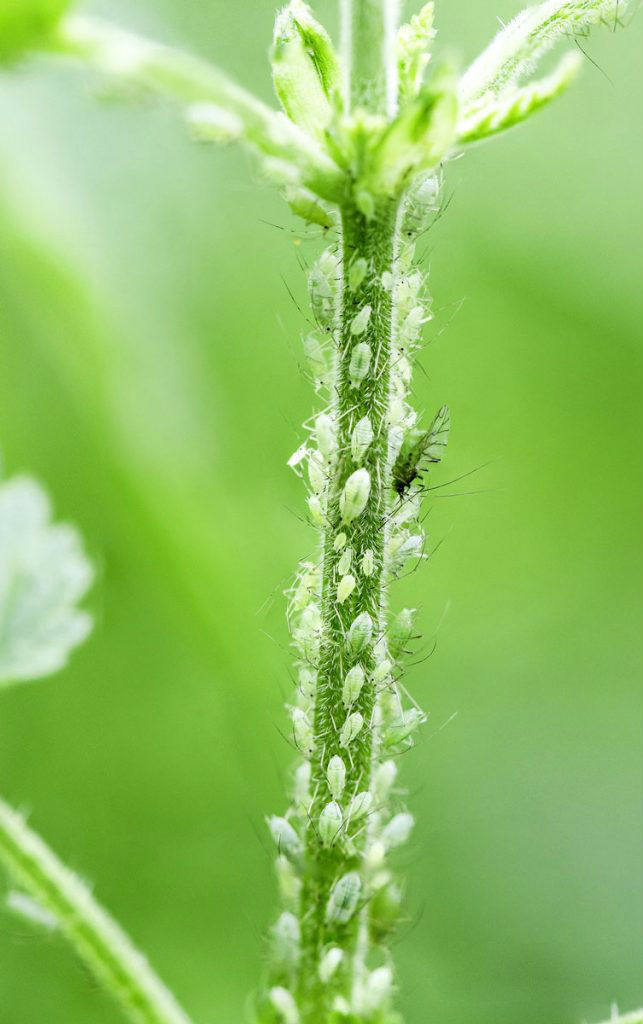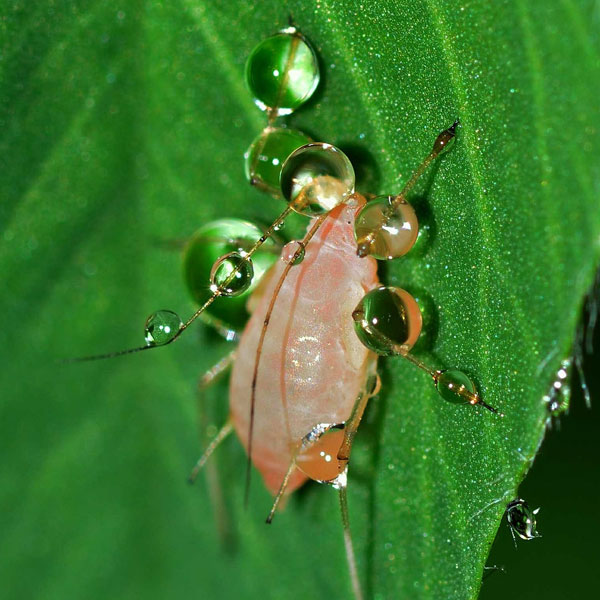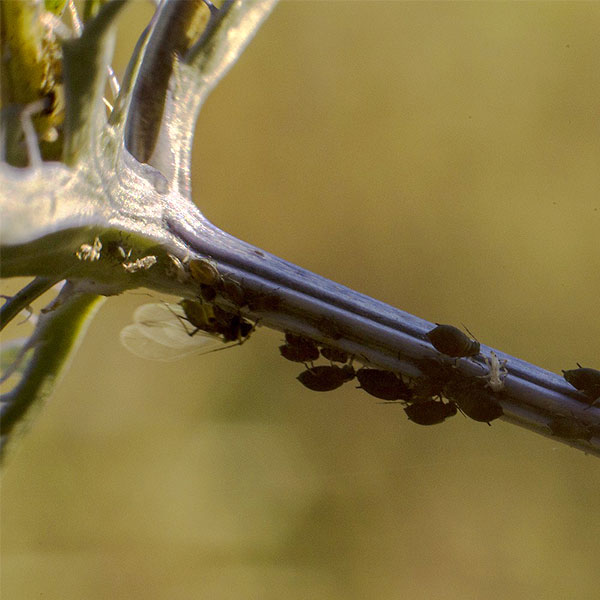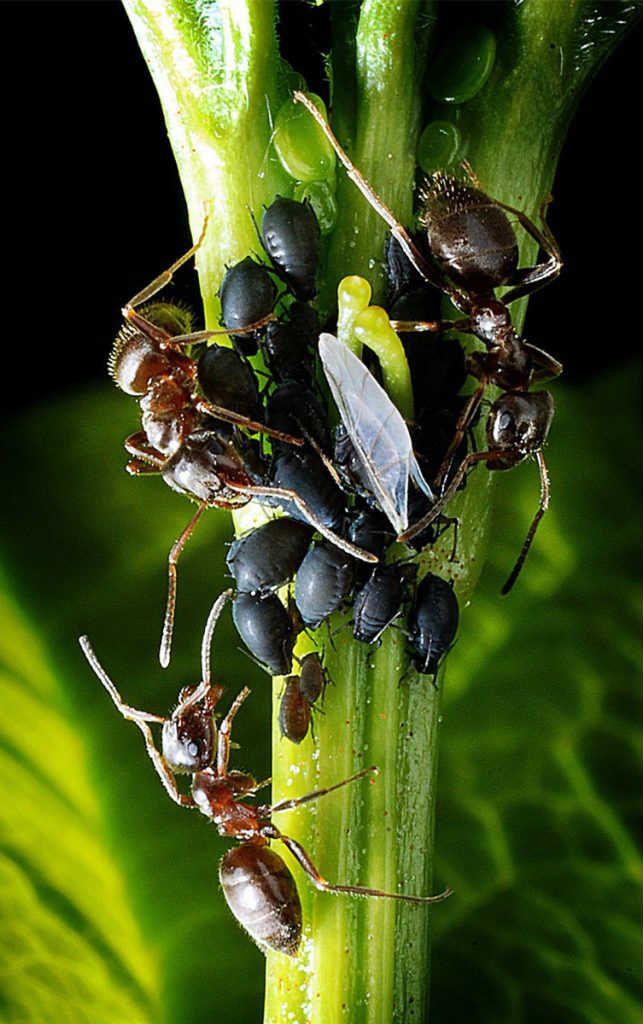What are Aphids?
Quick Facts About Aphids
- Aphid control includes using insecticides, insecticidal soaps, as well as high-pressure water treatment.
- Aphids are found in all types of plants.
- There are several types of aphid species.
- Few aphid species can cause plant injury.
- Some aphid species curl the new leaves of plants.
- Aphids feed on plants and also create a sticky waste called honeydew.
- Enemies of aphids are lady beetles, parasitoid wasp, lacewing and also flower fly larvae.
Are Aphids Harmful?
Aphids are the most common insect that can be found on trees, shrubs, as well as garden plants. There are over 350 aphid species, most only feed on specific plants. With so many species of aphids, nearly all the plants grown in Colorado support at least one of the aphid species. Most aphid species do not permanently injure plants, but a few can cause problems. Aphid control is important for preventing large amounts from coming back.
Aphids feed by sucking the sap out of plants. Plants that have a high number of aphids for long periods of time can cause wilting, buds and shoots can die back, and some can also cause leaf curling.
One of the main concerns when aphids infest a plant involves their production of honeydew, which is their waste material. This sticky substance can cover leaves, branches, sidewalks, and also anything on or beneath the infested plant. With the production of honeydew comes the growth of a gray mold, which affects the appearance of the plant. Other insects, such as yellow-jacket wasps, flies, as well as bees are attracted to plants affected with honeydew.

Common Aphids and Plants They Affect
| Type of Aphid | Host Plants |
|---|---|
| Acyrthosiphum pisum (Pea aphid) | Sweet pea and legume plants |
| Aphis helianthi (Sunflower aphid) | Red twig dogwood, many flowering plants in summer |
| Aphis nerii (Yellow milkweed aphid) | Milkweeds (Asclepias) |
| Aphis spiraecola (Spirea aphid) | Spirea |
| Aphis viburnicola (Snowball aphid) | Snowball viburnum |
| Brachycaudus helichrysi (Leafcurl plum aphid) | Plum |
| Caveriella aegopodii (Willow-carrot aphid) | European willows |
| Chaitophorus populicola | Populus |
| Chaitophorus populifolii | Populus |
| Chaitophorus viminalis | Willow |
| Cindara spp. (Giant conifer aphids) | Pines, juniper, spruce |
| Cryptomyzus ribis (Currant aphid) | Currant |
| Dysaphis plantaginea (Rosy apple aphid) | Apple |
| Dysaphis tulipae (Tulip bulb aphid) | Dutch iris, tulip |
| Eriosoma lanigerum (Woolly apple aphid) | Elm, apple, crabapple |
| Eriosoma amiercanum (Woolly elm aphid) | Elm, amelanchier |
| Essigella spp. | Pines |
| Eulachnus spp. | Pines |
| Hyadaphis tataricae (honeysuckle witches’ broom aphid) | Tatarian honeysuckle |
| Hyalopterus pruni (Mealy plum aphid) | Prunus |
| Macrosiphum rosae (Rose aphid) | Rose |
| Macrosiphum euphorbiae (Potato aphid) | Potato |
| Macrosiphum albifrons (Lupine aphid) | Lupine |
| Monellia caryae (American walnut aphid) | Walnut |
| Myzocallis tiliae (Linden aphid) | Linden |
| Myzocallis alhambra (Western dusky-winged oak aphid) | Bur oak |
| Myzocallis ulmifolii (Elm leaf aphid) | Elm |
| Myzus ceraki (Black cherry aphid) | Tart Cherry |
| Myzus persicae (Green peach aphid) | Peach, apricot, other Prunus |
| Nasonovia aquilegiae (Columbine aphid) | Columbine |
| Nearctaphis bakeri (Shortbeaked clover aphid) | Hawthorn |
| Periphyllus lyropictus (Norway maple aphid) | Norway maple |
| Prociphilus franxinifolii (Leafcurl ash aphid) | Green ash |
| Pterocomma bicolor | Populus |
| Pterocomma smithiae (Black willow aphid) | Willow |
| Rhopalosiphum cerasifoliae (Chokecherry aphid) | Chokecherry, pin cherry |
| Rhopalosiphum nymphaeae (Water lily aphid) | Prunus, various aquatic plants |
| Tuberolachnus salignus (Giant willow aphid) | Willow |
| Uroleucon sp. | Many flowers |
What do Aphids Look Like?
Aphids are small insects (six legs) that grow no larger than 1/8 of an inch. Their bodies have an oval form, and two small upright pointed tubes coming from the back. The colors of aphids are not restricted. They also come in a wide variety of colors depending on the different aphid species. Some range from a yellow to dark, almost black. Whereas others can have shades of green, orange, or even red. Many aphids species can have different pattern markings across their body.

Winged & Wingless Aphids
There are different colonies of aphids, many consisting of a mixture of winged and wingless species. The majority of aphids develop into a wingless form and stay on the plant to reproduce. Winged aphids usually only form when a colony becomes over populated, the plant quality is declining, or to spread to new plants.

The Spread of Aphids
Most aphids born are female, only a few generations of male aphids are born in late summer. Female aphids have the ability to give live birth to genetically identical daughters and can produce three or five per day. Newly born aphid daughters develop rapidly within 10 to 14 days. Aphids typically have a lifespan of about a month, but this can be shortened by natural enemies or getting aphid control treatments.
When plants are dormant or no longer active due to cold temperatures, different forms of aphids are produced during the end of summer. Durable eggs are produced and placed in protected areas within the plant, usually around a bud.

Common Aphids in Colorado
| Type of Aphid | Winter Host Plant | Summer Host Plant |
|---|---|---|
| Black cherry aphid | Woolly elm aphid | Wild mustards |
| Currant aphid | Currant | Wild mustards |
| Green peach aphid | Peach, plum, apricot | Peppers, cabbage, potato, many garden plants |
| Leafcurl plum aphid | Plum | Various aster-family plants, clover, vinca, thistle |
| Mealy plum aphid | Plum | Cattail, reeds |
| Potato aphid | Rose | Potatoes, tomatoes and many other garden plants |
| Rosy apple aphid | Apple, pear, mountain-ash | Plantain |
| Shortbeaked clover aphid | Hawthorn | Legumes |
| Sunflower aphid | Dogwood | Sunflower, yucca, parsley, cilanto, pigweed, many other herbacceous plants |
| Water lily aphid | Plum, other Prunus | Water lily and many other aquatic plants |
| Willow-carrot aphid | Willow | Carrot, parsley, dill |
| Woolly elm aphid | American elm | Amelanchier (roots) |
Aphid Control Management
Nature Management
Aphids are a defenseless insect and are a food source for numerous insects. The most common natural enemies of aphids are lady beetles (ladybugs). Aphids are also commonly killed by parasitic wasps. These wasps lay their eggs inside the aphid and when the eggs hatch, the larvae will consume the aphid from the inside out.
One thing to look out for with the increase of aphids is an increase in ants. Ants feed on the honeydew that aphids produce and therefore protect aphids as their own livestock.
Human Management
There are a variety of methods we can use for aphid control or removal. Using special soaps or oils, such as neem oil or insecticidal soap, helps control and repel against future aphids.

